|
FCC sets its sights upon using white strobes as preferred lighting and restricting guyed towers
December 8, 2006 - Conservationists and vertical realtors agree that communications towers are responsible for killing many night-migrating birds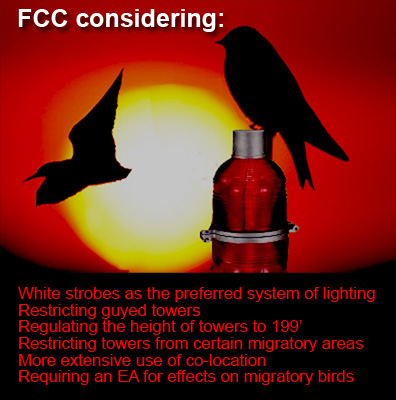 estimated to represent 230 species, and additional research is needed. estimated to represent 230 species, and additional research is needed.
Those are the only concurrences you'll find between the nature and technology groups as they prepare to square off again over the number of avian mortalities and viable solutions to prevent them from occurring following a re-launch of a Notice of Public Rulemaking by the Federal Communications Commission last month.
Spurred by environmental groups, the FCC said that it has tentatively concluded that tower owners should use medium intensity white strobe lights as the preferred lighting over red obstruction lighting systems for each new or altered registered antenna structure (See: WT Docket No 03-187 ), but it is looking for additional information before enacting that regulation.
The Federal agency believes that there is supporting data available to warrant the change to protect migratory birds from communications towers.
It also announced that to provide greater bird protection it was seeking comments upon limiting the use of guy wires on towers; marking existing guy wires with bird flight diverters; limiting the height of towers to 199' above ground level; restricting towers in specific habitats, such as wetlands, ridges and mountains; greater co-location on existing structures; an environmental assessment for new towers; and other procedural measures the Commission could take to minimize migratory bird collisions.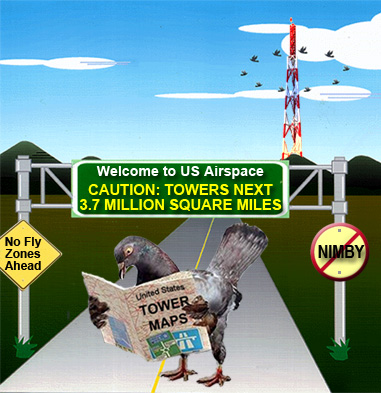
Statistics challenged
The U.S. Fish and Wildlife Service, which has pegged the annual deaths at 4 million to 50 million, has been challenged by industry associations as to the efficacy of their findings, saying there is no clear evidence that telecommunications towers pose a real threat to migratory birds and the broad fatality estimates fall short of ensuring any statistical confidence level.
Having tentatively concluded that it has the authority to act in this arena, the FCC is requesting information pertaining to the impact that any new rules in this area would have on other environmental issues, such as historical preservation and wetland protection. The NPRM also addresses how applicants would prepare an environmental assessment under the FCC's rules if it is determined that a particular project would have an impact on migratory birds.
The FCC in recent years has wrestled with the question of what extent communications towers -- with particular focus on height, location, lighting and other aspects of tall structures -- might be contributing to migratory bird deaths. This latest commission action is designed to build on the existing public record and to seek public comment on specific legal and scientific issues.
Commissioner Jonathan Adelstein, one of the two Democrats on the GOP-led FCC, said that legal issue should not be left ambiguous.
"I, for one, am confident in our legal authority under the NEPA and the Communications Act to take action, if appropriate, and do not think our conclusion on this issue should be a tentative one," said Adelstein.
"I took a similarly firm position on the legal effect of the National Historic Preservation Act in our consideration of the Nationwide Programmatic Agreement, a determination that was recently upheld in the U.S. Court of Appeals for the D.C. Circuit."
Lacking definitive studies on birds and towers, the communications industry questions the wisdom of adding costly new regulations at a time when more towers are needed for expanding cellular phone service and high-definition TV and radio broadcasts.
Maximum tower height of 199' being considered
Spurred by environmental groups with the American Bird Conservancy taking the lead, the FCC is considering whether to limit the height of towers to 199 feet, although a previous survey and comments by the National Association of Broadcasters identified that as high as 61% of the population served in major cities would not receive coverage with those limitations in place.
NAB also noted that wireless services that cover large footprints, such as public safety radio systems, are likely to experience significant decreases in service coverage if towers are capped at 199 feet. The result of such artificial limitations in tower height would significantly impair broadcast and wireless service, and inevitably disrupt critical and often life-saving services such as the broadcast emergency alert services, E-911, Amber Alerts and public safety communications, the NAB said.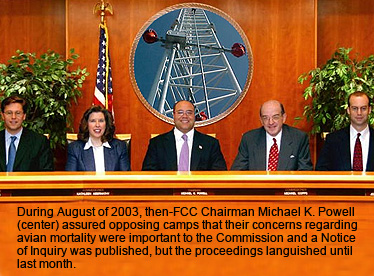
Tower owners are also quick to point out that similar to broadcast and public safety groups, wireless carriers would have to provide considerably more towers at 199 feet or less to provide a semblance of coverage in an environment that finds communities objecting to many sites necessary to fulfill basic coverage.
Industry observers believe that the less-than-200-foot rule stands little chance of being enacted; however, the FCC has a fallback option that they are considering that was proposed by the ABC to rein in birds being injured by colliding with guy wires: curtail all new construction of guyed towers and only allow self supporting structures.
The FCC is requesting information on engineering and economic factors relevant to the use of guy wires, questioning whether there is a height threshold above which guy wires are generally necessary of if a guy tower is necessary depending on soil conditions or other factors.
Engineers say that there would be few limiting factors that would not allow a self supporting structure to be placed on any site in lieu of a guyed tower no matter what the elevation above ground level is.
However, the cost can be astronomical, prohibiting a tower's construction. The FCC is also asking for comments in this regard as to what economic factors affect the decision to use guy wires.
Contractors says that if a footprint is available for a guyed tower which requires additional property to provide a typical 80% guying of the structure's height, the total construction cost is more economically feasible at greater heights.
Self support requirement cost could curtail deployment
A recent analysis of a 550' guyed tower by WirelessEstimator.com saw the  manufacturer's steel cost at $112,000 in a competitive market that might see slightly higher or lower offerings. A self supporting tower for the identical loading and height designed for a 110mph-basic-wind-speed saw the cost skyrocket almost 300% to $334,000. manufacturer's steel cost at $112,000 in a competitive market that might see slightly higher or lower offerings. A self supporting tower for the identical loading and height designed for a 110mph-basic-wind-speed saw the cost skyrocket almost 300% to $334,000.
When the additional freight for the self supporting structure was added as well as the higher foundation and erection expenses, engineering, furnishing and installing the self supporting tower totaled $327,000 more than its sister structure, an increase that would allow for a second guyed tower to be built.
Rules could impact local public safety
The FCC is required by the Regulatory Flexibility Act to consider the economic impact of their actions upon small businesses and non-profit organizations as well as communities with populations of less than 50,000 residents. More than 87,525 of these jurisdictions rely upon their local communications structures for emergency services.
"It will be interesting to see if there is any pushback from these smaller communities," questioned a manufacturing executive who believes that there isn't enough credible avian mortality data to warrant any additional rules by the FCC.
"I find it ironic. At a time when everybody agrees that our public safety communications systems need a major overhaul, the FCC is considering limiting the infrastructure as well as increasing the cost needed to provide it," he said.
White strobes could be preferred lighting system
The FCC said that it has tentatively concluded that the use of medium intensity white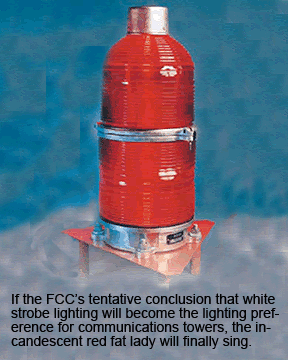 strobe lights for nighttime obstruction lighting is to be the preferred lighting system over red obstruction lighting systems based upon information they have reviewed from the ABC and other conservation groups. strobe lights for nighttime obstruction lighting is to be the preferred lighting system over red obstruction lighting systems based upon information they have reviewed from the ABC and other conservation groups.
The agency believes that there is sufficient data and reports over the years indicating that during bad weather, birds can mistake tower lights for the stars they use to navigate, circling a tower as if mesmerized, often until they crash into the structure, its guy wires or other birds. Sometimes disoriented birds simply plummet to the ground from exhaustion, some studies state.
Researchers say red light waves may interfere with the magnetic compass of migratory birds, and some studies have indicated that blinking lights are less appealing.
"If you have a strobe light that even allows for a momentary period of darkness, it breaks that sort of spell and the birds are allowed to escape," said Darin Schroeder, deputy director of conservation advocacy at ABC.
The FCC said that it is aware that white strobe lights might be a concern for nearby residents and could possibly have an impact on the deployment of communications towers, but they say they're not in receipt of conclusive information that this concern is evident.
Better no red than dead
The FCC's preference for white strobe lights is largely based upon interim reports of the 2003 through 2005 studies that were untaken by Dr. Joelle Gehring at the Michigan Public Safety Communications System's towers, indicating that comparable numbers of bird carcasses were found when only red strobe or only white strobe lights were used, irrespective of the towers' heights and the presence of guy wires. The interim reports also indicated more bird carcasses were found at towers using red steady lights with red strobe lights than at towers using only red strobe, white strobe, or red blinking incandescent lights.
|
Current FCC Positions (click here)
The FCC has provided their Notice of Proposed
Rulemaking (NPRM) In the Matter of Effects of
Communications Towers on Migratory Birds.
WirelessEstimator.com has taken the agency's lengthy document and placed the content in a format that is easily navigated to quickly identify key points of interest.
Comments Submitted (click here)
On December 8, 2006 there were 314 comments
sent to the FCC on the subject since August 20, 2003.
They provide for an interesting read, but you'll find that
the majority are cut-and-paste emails generated from
conservation group campaigns.
Submit Your Comments (click here)
You can submit your comments directly to our forum
which we in turn will summarize and send to the FCC
prior to the due date of January 22, 2007. Or you can
send your comments directly to the FCC through their
Electronic Comment Filling System.
|
An industry coalition comprised of CTIA - The Wireless Association, National Association of Broadcasters, and PCIA - The Wireless Infrastructure Association previously commented to the FCC that it believes valid research work has not been conducted and must be properly reported before specific design recommendations are incorporated into or amend a Federal policy on the build-out and deployment of the nation's communications towers.
The coalition said, "Contrary to the assertions of the avian groups, their comments and materials are neither scientifically sufficient, nor do they warrant further regulatory action by the Commission in this area at this time."
The National Association of Tower Erectors, the first industry association to address the issue with the FCC in 2003, has joined the coalition to lend its support to the group and present its previous research on avian fatalities. NATE lobbyist Jim Goldwater said that the association was troubled by suggestions that action must be taken despite inadequate science.
"We are resolute that there is not enough science or research to warrant any punitive action or mitigation steps at this time. We are greatly concerned that if a step such as a different lighting scheme is implemented, it will not only be costly, but down the road it could conceivably lead to enough residential consternation that citizens could balk against the siting of towers to what they believe is an offensive lighting scheme," Goldwater said.
Asked and answered, Mr. Chairman
Many of the questions proposed in the NPRM have been asked before in the 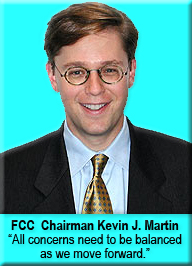 Commission's 2003 Notice of Inquiry and responded to with lengthy reports, but the FCC says that there was such a difference of opinion that no conclusions could be reached. Commission's 2003 Notice of Inquiry and responded to with lengthy reports, but the FCC says that there was such a difference of opinion that no conclusions could be reached.
A study was commissioned by the FCC to assist in evaluating the submitted research.
The Avatar Environmental consulting group provided recommendations in 2004 in a 225-page report, but it stated that more studies were needed to identify specific causes and viable solutions.
Pro-avian groups that reviewed the Avatar Report provided their response in the Longcore Report which was countered by tower groups with the Woodlot Report which said the Longcore Report was filled with analyses and conclusions that were not supported by scientifically valid data and peer-reviewed research.
It is not known if any additional studies have been undertaken by conservation groups, but tower associations will be carefully monitoring comments submitted to the FCC to ensure that they can assess and respond to any new data.
Chairman Kevin J. Martin explained last month, “All concerns need to be balanced as we move forward” on the issue.
Just say no to negotiating?
Some tower-industry leaders believe that there should be room for compromise between the divided camps. The FCC is trying to please everyone and would welcome any justifying change to existing regulations as long as it didn't allow the Department of Interior, U.S. Environmental Protection Agency or Federal Aviation Administration to usurp its authority. 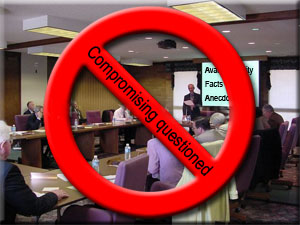
However, a number of industry participants in the NPRM process think that there should be no compromise whatsoever. One industry observer believes that none of the FCC's conclusions or inquiries should be agreed to.
"If you look to create some type of compromise to solve this issue, you're tacitly acknowledging that there is a problem that has been created by communications towers and lighting systems. To date, the FCC has received no clear evidence to justify any changes," he said.
Others believe that if lighting systems are changed and it is later found that there is another cause resulting in avian mortality, then it would provide a green light for an additional modification that the FCC deems necessary.
Earlier this year, when the FCC denied a 2002 request from the American Bird Conservancy and the Forest Conservation Council to study whether wireless towers contribute to the death of migratory birds, PCIA was more forward about where it believes the scientific evidence points.
"There is no clear evidence that telecommunications towers pose a real threat to migratory birds. It is reassuring that the FCC refused to act on the basis of an inconclusive record," said PCIA President Michael Fitch.
| The appeal of the Gulf Coast region petition "moves our case forward and lets the FCC and industry know that the day of reckoning on the merits of the FCC handling of towers and birds is coming before a federal appeals court." -- Gerald W. Winegrad |
Fitch will have another opportunity to comment upon the issue since the court's dismissal of the petition is being appealed. Earthjustice attorneys will present opening briefs before the federal appeals court in the District of Columbia by December 18, with the FCC's response due January 23.
The appeal of the Gulf Coast region petition "moves our case forward and lets the FCC and industry know that the day of reckoning on the merits of the FCC handling of towers and birds is coming before a federal appeals court," said Gerald W. Winegrad, an attorney for the Washington, D.C.-based ABC.
Another suit challenging seven towers on two Hawaiian islands, with heights of 200 to 420 feet, was dismissed last January 2006 on jurisdictional grounds and also is on appeal.
Changing a bulb is not inexpensive
Birders believe that flyways will be protected if lighting systems are changed, an 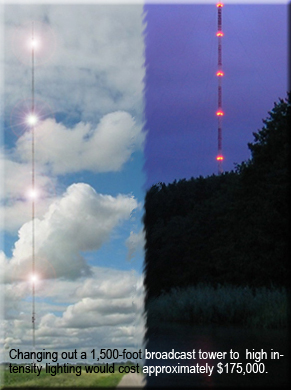 inexpensive consideration, some say. inexpensive consideration, some say.
Peggy Ridgway, a former president of the Michigan Audubon Society agrees that there is a cost to existing towers, but believes "it takes a small change of a light bulb to make a big difference in bird mortality."
The ABC skirts the cost of a new lighting system in its correspondence to the FCC, but emphasizes the lower energy costs of strobe lighting systems versus incandescent lighting.
Although they are correct in their power usage assumptions, adding new lighting requirements could increase costs to tower owners substantially, particularly if the FCC were to require that all existing tower lights be replaced, as some conservation groups are requesting.
The power usage issue, tower owners point out, is a red herring. They say new systems could cost anywhere from $4,000 for a single medium intensity unit to $100,000 for a high intensity lighting system for a 1,500-foot broadcast tower. In addition, the cost would be increased by installation expenses as well as the labor to remove the existing system, elevating the broadcast tower's cost to approximately $175,000.
Infertility could be next challenge to address
The most recent challenge to the communications industry was a recommendation published December 6, 2006 by The EMR Policy Institute for the FCC to take immediate precautionary action pending completion of studies of the effects of radio frequency radiation from communications towers in causing migratory bird infertility.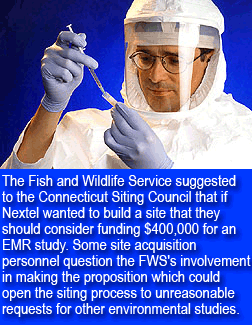
The non-profit public policy group wants to prohibit the nighttime operation of communications towers within five miles of any known migratory bird flyway in addition to prohibiting the siting or operation of any communications towers or antennas within two miles of sensitive bird nesting areas or habitats of endangered and/or listed species.
Their concern was partly prompted by an April letter to the Connecticut Siting Council from the FWS that said that preliminary research in Spain has shown strong negative correlations with levels of tower-emitted microwave radiation and bird breeding, nesting, and roosting in the vicinity of these electromagnetic fields which included nest and site abandonment, plumage deterioration, locomotion problems, and death.
However, The EMR Policy Institute failed to inform the FCC that the FWS-referenced infertility study used laboratory mice that were treated with radiation to replicate tower site conditions, and it was found that after five generations of newborns, irreversible infertility occurred - but the report's conclusion also stated that "What similar effect antennas may have on birds is unknown."
FWS Supervisor Michael J. Bartlett suggested to the Connecticut Siting Council that in considering Nextel's application in Falls Village, that they should suggest to the carrier that their Beebe Hill site would be an excellent experimental control site. The cost, Bartlett says, for a "scientifically robust, statistically sound, three-year study" would be approximately $400,000.
New NEPA would see immediate challenges
Although it is doubtful that the FCC would require a NEPA on migratory birds for every tower structure in the country, if they did conclude that it was necessary, legal challenges would stall the regulatory process for years to come.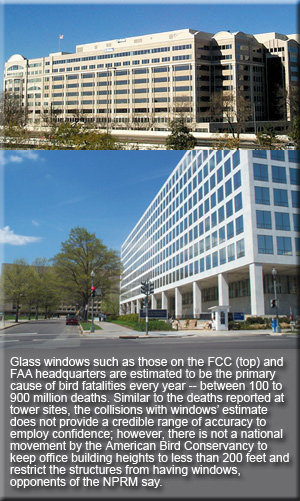
Tower industry groups have previously stated that they disagree that the estimates of total human-caused bird mortality are not relevant to determine whether kills at communications towers meet the NEPA standard for a significant impact.
Their attorneys argue that the legal test under NEPA is whether the "human environment" is being "significantly" affected by losses of birds as an environmental resource in a way that is fairly traceable to communications towers.
They state that there is no credible data available for the FCC to determine whether communications towers are significantly affecting avian species populations without evaluating avian tower strikes in proportion to total human-caused bird mortality.
The National Audubon Society says 100 million birds a year are killed by cats. Glass windows are estimated to be the cause of between 100 to 900 million deaths each year. Electric transmission line collisions account for up to 174 million, plus hundreds of millions more from agriculture pesticide poisoning, hunting and other causes.
CTIA and NAB maintain that the FWS's 4 million to 50 million bird kills is inaccurate. However, the two industry associations will use the FWS's 2002 published estimate to identify that a minimum of 10 billion birds breed in North America and the migratory bird population could be 20 billion in the fall.
The groups say that if there are 10 billion migratory birds nationwide, 5 million deaths caused by communications structures would account for only a 0.05% reduction of the migratory bird population each year.
Some conservationists say there might be some simple solutions, such as shields to focus the light upward for pilots.
One recent FCC commenter suggested the use of 80 wind driven whistles and an alternative of using gongs or sounding devices like wind chimes that would be installed at points along the tower.
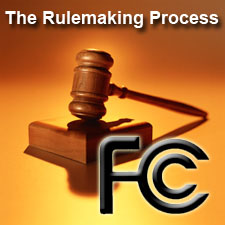 How the issue proceeds following the NPRM request: How the issue proceeds following the NPRM request:
The FCC can issue a Notice of Proposed Rulemaking (NPRM) such as In the Matter of Effects of Communications Towers on Migratory Birds . The NPRM will contain proposed changes to the Commission's rules and seeks public comment on these proposals.
After reviewing all of the comments to the NPRM, the FCC may also choose to issue a Further Notice of Proposed Rulemaking (FNPRM) regarding specific issues raised in comments. The FNPRM provides an opportunity for interested individuals and organizations to comment further on a related or specific proposal.
After considering comments to a Notice of Proposed Rulemaking (or Further Notice of Proposed Rulemaking), the FCC issues a Report and Order. The R&O may develop new rules, amend existing rules or make a decision not to do so.
Summaries of the R&O are published in the Federal Register. The Federal Register summary will tell you when a rule change will become effective. |
|